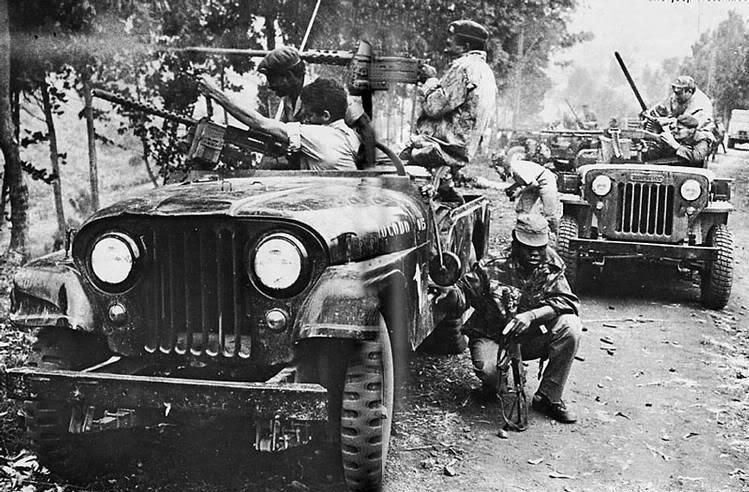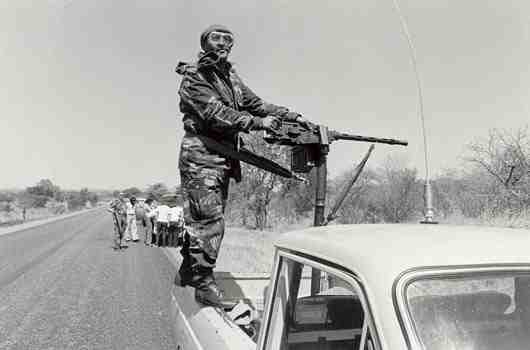This was the brief we used for the Battle of Caxito, played using Peter Pig's AK47 Reloaded rules with some adaptations
Caxito 3 November 1975
Situation
Task Force Blue, an FNLA unit originally of brigade strength, has reached Caxito, about 30 kms from Luanda.
The Task Force is led by an Anglo-Irish mercenary and former Royal Marine Commando non commissioned officer, ‘Colonel’ Carlo Shannon. Since crossing the border with Zaire two weeks ago Shannon’s force has dwindled to around 1000 men, about 60 of whom are British, French and Portuguese mercenaries. They are well supplied and have plenty of transport in the shape of lorries, jeeps, landrovers and the ubiquitous Japanese built pick up trucks. There is no artillery support however, and morale is brittle.
FNLA cadre in Luanda have been decimated and guerrilla units in the surrounding countryside have been largely destroyed by the MPLA’s military wing, FAPLA. FAPLA is well armed with Soviet supplied light weapons such as AK 47s and RPG launchers. There are around 30 Cuban advisors fighting alongside the FAPLA front line units. At the end of October a Cuban registered ship, the ‘Vietnam Heroico’, docked in Luanda and unloaded a cargo of heavier weapons and ammunition. Half a dozen BM-21 multlple rocket launchers and the specialist troops to operate them arrived with the cargo.
Against Shannon’s advice, the political leader of the FNLA, Holden Roberto, the brother in law of Zaire’s dictator, President Mobuto, has insisted that Task Force Blue launch an attack on the capital. Angola is due to be granted independence on 11th November, although Portuguese colonial rule has effectively already collapsed, and Roberto wants to install a government by then.
The fighting is bloody and confused. As Task Force Blue makes its bid to capture Luanda front lines cease to exist and a mobile free for all of attacks, ambushes and counter attacks ensues.
Deployment
The FNLA are the attacking force. Divide the table into four quarters. The FAPLA player chooses two diagonally opposite quarters and choose two objectives in these quarters. The FNLA player identifies another objective in either of these quarters.
The FAPLA player deploys two units in his quarter(s).
The FNLA player deploys three units in his quarter(s).
Forces
FAPLA
Commander & HQ stands (prof)
1st Company (militia)
6 x small arms
3 x RPG
2nd Company (militia)
6 x small arms
3 x RPG
Mobile detachment A (regular)
3 x HMG technicals
Mobile detachment B (regular)
3 x RCL technicals
The FAPLA player has an artillery asset of 12. This represents the BM-21 unit. Should it come into play it has the same effect as an airstrike so as to represent the devastating effect of massed rockets on morale.
FNLA
Command & HQ stands (prof)
Alpha Company (militia*)
1 x small arms stand (prof) mercenaries
5 x small arms (militia)
2 x Unimog Trucks
Bravo Company (militia*)
1 x small arms stand (prof) mercenaries
5 x small arms (militia)
2 x Unimog Trucks
Charlie Company (regular)
4 x HMG Technicals
1 x AA Technical
Delta Company (regular)
2 x HMG Technicals
1 x RCL Technical
3 x small arms
1 x Unimog Truck
* these units fight as regulars whilst the mercenary stand remains with them. As soon as it is destroyed or lost they revert to being militia
The FNLA player has an aggressive shot asset of 12, this represents the plentiful supplies of ammunition Shannon has been furnished with courtesy of the CIA.
Arrivals
Can be diced for from turn 2 as per the rules. The table edge of any enemy quarter is an enemy base edge and there are no ‘flank’ edges.
Victory
Countdown is from 21. At game end victory points are allocated as follows:
Defender
1D6 + 3 to offset numerical disadvantage and lack of mobility
D6 + 2 for each objective held
2D6 + 1 enemy command destroyed or fled
2D6 + 1 each enemy unit destroyed or fled
+ 2 for each template occupied by foot
+ 2 for each destroyed enemy vehicle
+ 1 for each destroyed enemy foot stand
Attacker
2D6 + 4 for each objective held
2D6 + 1 enemy command destroyed or fled
2D6 + 1 each enemy unit destroyed or fled
+ 2 for each template occupied by foot
+ 2 for each destroyed enemy vehicle
+ 1 for each destroyed enemy foot stand












